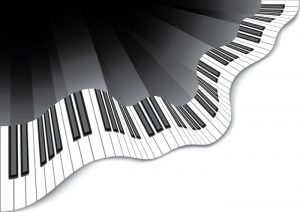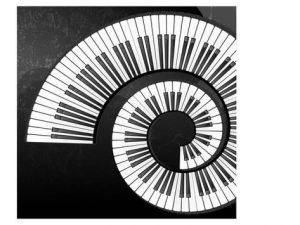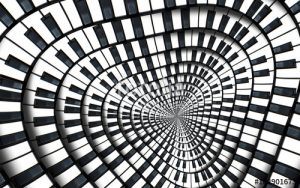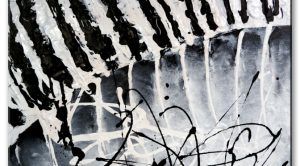“The piano ain’t got no wrong notes.”
~ Thelonious Monk
 It’s with a certain pleasure that I can recall the exact moment I was seduced by the musical avant-garde. It was in the fourth grade, in a public elementary school somewhere in New Jersey. Our music teacher, Mrs. Jones, would visit the classroom several times a week, accompanied by an ancient record player and a stack of LPs. You could always tell when she was coming down the hall because the wheels of the cart had a particularly squeak-squeak-wheeze pattern. However, such a Cageian sensibility was not the occasion of my epiphany. I’m also not sure if fourth-graders are allowed to have epiphanies, or, which is likelier, if they are not having them on a daily basis.
It’s with a certain pleasure that I can recall the exact moment I was seduced by the musical avant-garde. It was in the fourth grade, in a public elementary school somewhere in New Jersey. Our music teacher, Mrs. Jones, would visit the classroom several times a week, accompanied by an ancient record player and a stack of LPs. You could always tell when she was coming down the hall because the wheels of the cart had a particularly squeak-squeak-wheeze pattern. However, such a Cageian sensibility was not the occasion of my epiphany. I’m also not sure if fourth-graders are allowed to have epiphanies, or, which is likelier, if they are not having them on a daily basis.
Rather, it was a record that she cued up for us one day: Henry Cowell’s ‘The Banshee’, originally composed in 1925. Originating in Irish folklore, the banshee is a female spirit whose keening announces the imminent death of a family member. Cowell sought to evoke the supernatural terror such an encounter might elicit by creating a composition for piano where no keys are actually depressed – instead, the performer plucks and rakes the strings of the piano directly. With the damper pedal pressed down, the tones so generated are freely sustained, and the adjoining wires ring out in consonant vibration, creating a rich set of overtone resonances that add to the unearthly textures that hang in the air. My fourth-grade self was transfixed, and although I can’t remember anything else we did in Mrs. Jones’s class, that occasion remains in my memory with an almost crystalline clarity.
Cowell’s piece was perhaps the first that entirely press-ganged the piano into such unusual service, and composers have since developed all manner of techniques that loosely fall under the monikers of ‘prepared’ and ‘extended’ piano. Cowell’s is an example of extended technique, while prepared piano generally involves placing objects directly on a string to modify the timbre when the string is sounded. These objects can include pieces of paper, rubber erasers, coins and even kitchen cutlery (suffice to say that concert hall managers are not keen on much of the prepared piano repertory, since they believe these objects and the oils from performer’s hands abrade and oxidize the wires).
John Cage’s works are probably the best known in the prepared piano repertory, such as it is, and the innovation itself is a good example of invention being the mother of necessity: in 1940, Cage had been mostly writing for percussion, and was working on a score for a dance performance by Syvilla Fort. While the hall did not have room for a percussion ensemble, it did have a grand piano. Cage, once a student of Cowell’s, eventually realized that, by treating the strings with all manner of objects, he could “place in the hands of a single pianist the equivalent of an entire percussion orchestra”.
A particularly representative example of this is his ‘Three Dances For Two Prepared Pianos,’ which clearly evinces an almost gamelan-like quality. Cage wrote consistently within this idiom from about 1940 to the mid-1950s. Most of the pieces are short and playful, even mischevious; their brevity has a Satie-like quality. However, the technique, while compelling, is inherently limited, because the timbres so produced are always percussive in nature. Practitioners of the extended technique have managed to coax a much broader sonic palette from the piano.
*
 Fast forward about fifteen years from the fourth grade: I am in a used music shop in San Francisco, where I pick up a CD of two of Stephen Scott’s compositions: ‘Minerva’s Web/The Tears Of Niobe’. I had no idea who Scott was, but I was immediately taken by the description – ‘for grand piano bowed and plucked by ten musicians’ – and the photograph of said musicians, reverently poised over the soundboard of a grand piano stripped of its lid, the light pouring upwards, as if Caravaggio had decided this to be a worthy subject for a painting.
Fast forward about fifteen years from the fourth grade: I am in a used music shop in San Francisco, where I pick up a CD of two of Stephen Scott’s compositions: ‘Minerva’s Web/The Tears Of Niobe’. I had no idea who Scott was, but I was immediately taken by the description – ‘for grand piano bowed and plucked by ten musicians’ – and the photograph of said musicians, reverently poised over the soundboard of a grand piano stripped of its lid, the light pouring upwards, as if Caravaggio had decided this to be a worthy subject for a painting.
The sounds that Scott scrupulously draws out of the piano demostrate the breadth of extended technique. Working from a single instrument, the performers elicit an astonishing range of sound. For example, ‘Minerva’s Web‘ is a gradual coalescence of violins, cellos, clarinets, bass clarinets and oboes, all delineated with an exacting ear. The piece has a gorgeous, limpid quality that evokes a Philip Glass-style minimalism, but, because it is born out of a single instrument and its attendant acoustics, also has a commingled, organic quality that seems to transcend ensemble playing.
In this live recording of ‘Entrada’ you can see the performers at work. As the composition progresses, the palette encompasses drums, harpsichords, tanpura and even, to my ears, the lute as played in Arabic and North African music. In a sense, Scott’s extended technique is not unlike tasting the flavor of other foods in a glass of well-made wine. It may take a moment to find the grapefruit in that sip of sauvignon blanc, but once you have identified it as such, it becomes an integral, unignorable part of that particular bottle. And yet, the wine is still only made of grapes, and the piano is still just that. Such are the pleasures of deception.
*
 The introduction of electronic possibilities has extended the range and character of the piano even further. The mixing of acoustic and electronic sounds, as well as the possibilities offered by effects, both real time and in the studio, as well as careful editing, have opened up vast new landscapes that musicians will continue to explore for many years. For example, consider ‘Zodiac Antique,’ a piece composed in 1991 by the Romanian composer Ana-Maria Avram, a proponent of the so-called Hyper-Spectralist school. In it, she draws on techniques first outlined in Cowell’s ‘Banshee’ but pairs the steely sheen created by raking the open strings of the piano with tape-based drones. These drones lend a stability to the kinetics of plucking and swiping, creating a delicately suspended atmosphere of suspense and dread. Interestingly enough, this electroacoustic tendency makes the music available for further dialog with more contemporary musicians: a fragment of ‘Zodiac’ can be heard at the beginning of electronic producer Rrose’s 2012 mix for the Resident Advisor series.
The introduction of electronic possibilities has extended the range and character of the piano even further. The mixing of acoustic and electronic sounds, as well as the possibilities offered by effects, both real time and in the studio, as well as careful editing, have opened up vast new landscapes that musicians will continue to explore for many years. For example, consider ‘Zodiac Antique,’ a piece composed in 1991 by the Romanian composer Ana-Maria Avram, a proponent of the so-called Hyper-Spectralist school. In it, she draws on techniques first outlined in Cowell’s ‘Banshee’ but pairs the steely sheen created by raking the open strings of the piano with tape-based drones. These drones lend a stability to the kinetics of plucking and swiping, creating a delicately suspended atmosphere of suspense and dread. Interestingly enough, this electroacoustic tendency makes the music available for further dialog with more contemporary musicians: a fragment of ‘Zodiac’ can be heard at the beginning of electronic producer Rrose’s 2012 mix for the Resident Advisor series.
In fact, electronic producers have flocked to the piano as an irresistible resource for manipulation, mangling and general plunder. Some, like seminal producer Aphex Twin, have re-engaged the prepared piano tradition: ‘Jynweythek Ylow,’ from the 2001 album ‘Drukqs’, is a direct descendant of Cage’s approach. Robert Worby recounts the origins of this re-visitation:
[Aphex Twin’s] music was being played along with the usual fabulous eclectic mix that [the BBC’s ‘Mixing It’] offers every Sunday night. One of Cage’s prepared piano pieces was played and Mr Aphex’s ears were drawn to the extraordinary sounds. He enquired about the prepared piano and how it was all done. Many other techno artists would have probably prepared a piano and sampled some of the sounds, but not Richard James, he knew this simply wouldn’t work and that any results of this process would be crass. He bought a grand piano that can be played by computer. It’s called a ‘Diskclavier’ and it’s made by Yamaha. It’s exactly like a straightforward grand piano but the keys can be controlled by a computer via MIDI – the musical instrument digital interface. Richard James cannot read conventional musical notation and he cannot play a keyboard so, in order to make the piano and prepared piano pieces that appear on ‘Drukqs’ he prepared his Diskclavier according to the principles established by John Cage and programmed the playing using a computer.
(It’s worth a brief detour to mention that this act of automation is not without precedent. Yamaha’s Diskclavier is a modern reincarnation of various varieties of self-playing pianos, also known as player pianos or pianolas, whose development was well underway by the mid to late 19th century. The craze for these instruments, while substantial, peaked by 1930. Nevertheless, the avant-garde finds its own uses for things, and composer Conlon Nancarrow would go on to write more than 50 studies for player piano, starting in 1948 and only concluding in 1992. Nancarrow wrote for pianola because his compositions were too demanding for human performers. They have a certain relentless, manic exuberance to them (see, for example, ‘Study No. 37‘), which in turn has provided inspiration for today’s producers. Veteran techno producer Thomas Brinkmann dedicated his merciless 2016 album ‘A 1000 Keys‘ to Nancarrow, and the latter’s influence on tracks such as ‘LHR‘ is immediately apparent.)
*
 While electronics can completely dominate the production of sound, creating performances that no human could possibly manage on their own, some musicians are using technology to augment their playing. Consider Norwegian pianist Kjetil Husebø’s ‘Piano Transformed,’ from the eponymous 2017 album. Husebø plays the piano but its sounds are then fed into electronics that heavily process the source material, creating a sort of diaphanous context that is at once part of and completely independent of the more conventional sounds to which we are accustomed.
While electronics can completely dominate the production of sound, creating performances that no human could possibly manage on their own, some musicians are using technology to augment their playing. Consider Norwegian pianist Kjetil Husebø’s ‘Piano Transformed,’ from the eponymous 2017 album. Husebø plays the piano but its sounds are then fed into electronics that heavily process the source material, creating a sort of diaphanous context that is at once part of and completely independent of the more conventional sounds to which we are accustomed.
Still other producers have turned to the piano as source material, and chosen to extend its sounds and capabilities completely within the context of the studio. The first track on Russian producer COH’s ‘Strings’ double CD, ‘Piano Tranquilo‘, is made up entirely of manipulated samples of a Yamaha grand piano recorded in 2001 by COH, aka Ivan Pavlov. While there is no evidence of either extended or prepared technique, as would have been understood by Cowell or Cage, Pavlov sucks the recordings into the digital ether, where he distends their duration so that the notes seem to quiver and wink in and out of existence. The usual attack and decay of a note played on the keyboard is smeared and wrinkled, although the sonority of the piano itself remains carefully preserved and remarkably consistent. It is as if the piano has been decomposed into its ethereal, tremulous counterpart, an instrument whose notes are made of fireflies on a summer’s evening.
Finally, Erik Satie is, unsuprisingly, a darling of the post-piano crowd. Who can resist those open, plangent harmonies? And you could drive a truck through the spaces that Satie creates in his ‘Gnossiennes’ and ‘Gymnopédies.’ The possibilities for reinterpretation are irresistible. For one, Mexican producer Murcof, in collaboration with pianist Vanessa Wagner, takes things to an extreme with his interpretation of Satie’s ‘Gnossienne No.3.’ Murcof bullies the piano, forcing it in and out of focus, and subjecting it to gestures of deep distortion. At certain points the ‘piano-ness’ is utterly wiped out, but then somehow returns. It is as if the music is drowning in the waves of some post-apocalyptic world, not quite managing to stay afloat, but not quite ready to sink yet, either.
I’ll end with an interpretation of another Satie piece, ‘Gymnopédie No.1′. Executed by the Brooklyn producer Hey Exit, it is a masterpiece of conceptual simplicity. Hey Exit does not play the piece, but rather takes every recording he could find – about 60, if I recall correctly – and layers them so that all the recordings converge at their common midpoint. This creates a fantastic, shimmering effect, replete with an organic randomness that throws a completely new light on what is usually an overplayed piece (the long version, which stretches the original to five times its length, is even better). Add to this the stimulating thought that what we are actually listening to are the palimpsests of dozens of pianists, performing the same piece across a span of decades, and one can truly appreciate the staying power of a single instrument.
